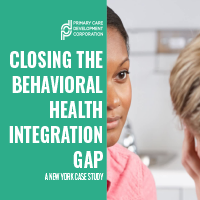PCDC’s Five Year Business Plan (2024-2028)
Reports
This case study focuses on the integration of primary care into behavioral health, where the gap between chronic health conditions and medical care is perhaps most profound. Included are in-depth profiles and policy recommendations.
Download Resource
In the United States, health care is typically provided in silos with limited interaction or coordination between primary care and behavioral health providers. Although primary care providers are increasingly screening for and treating common behavioral health conditions such as depression and anxiety, they only reach a fraction of people who require services.
One innovation to address the evident need to improve outcomes and reduce costs in the current delivery system is the integration of behavioral health and primary care for patients with mental and physical health comorbidities. There is no “correct” model or direction of integration — health providers must adapt and implement the most appropriate mode of care for their population and setting.
This case study serves as a framework for providers, policymakers, and other stakeholders to consider as they implement and advocate for programs and policies that support behavioral health integration.
Use the Download Resource link above to read this report.